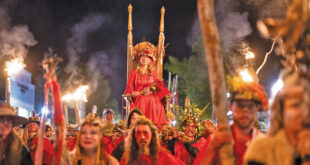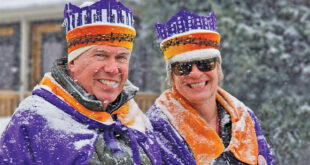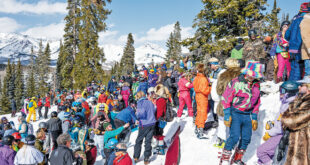Even those people in the audience who hadn’t been 8,000 meters high in the Himalaya or Karakoram mountain ranges could feel the pull of gravity and the vast space. Mountain climbing expert Chhiring Dorje Sherpa told them, in broken English, about bodies strewn about the high peaks. Then, in a change of fate, he became at risk of becoming one of those bodies.
“After we talked in 2007, Eric [Meyer of Steamboat Springs] said he wanted to go on a 2008 K2 expedition,” Chhiring told a standing room-only crowd at Western State Colorado University Monday, December 10. “Okay, I also like to go K2 climbing.”
Meyer asked if Chhiring (pronounced ‘shearing’) could climb the world’s deadliest and second highest mountain without oxygen. Chhiring said he could.
“We spent 60 days and it was a terrible time at K2,” Chirring recalled, with the weather making climbing difficult.
But the journey would cement Chhiring’s place in mountaineering lore for the bravery and strength he summoned, as he descended 500 meters with a friend and fellow Sherpa strapped to his back.
The Abruzzi Route up K2 is infamous for its 45-plus-degree pitch and exposure. Nearly a quarter of the climbers who embark on the 28,611-foot peak never return. And as Chhiring’s friend and handler Matt Tredway put it, actually reaching the summit is almost a curse, as a full third of the people who reach the top die on the way down.
Chhiring’s curse came late in the day. “We summit 6:30 p.m., but very good sunshine,” he said. “We turned back at 7 o’clock in the evening.”
With the sun going down, Chhiring and two Sherpas from two other teams pushing for the summit that day made their way through the deep snow, hoping to start the descent before the darkness overwhelmed their small headlamps.
“After 8 o’clock, I was very tired and rest. We don’t have the [fixed] rope. The snow was deep and it was too dark. We rest there. Very good sleep and I wake up and look at my watch, 9 o’clock. In the front there were two Sherpas. I don’t see these two guys and I’m very scared.”
Chhiring got his start in mountain trekking 1991, when he was just 16 and has since been to the top of the world’s highest mountains, summiting Mount Everest 11 times, Cho Oyu five times, and Shishapangma and Makalu each twice. He’s been to the top of Lhotse, Himlung Himal, Pumari and Amadablam.
In all of those expeditions, Chhiring’s wife had never felt his leaving as a loss. She never cried, he said. But before leaving Katmandu for K2, she did. Then on that August night in 2008, after reaching the summit, he feared she had known something he hadn’t.
“Many times I’m thinking what to do. I see my wife crying, like in a dream. I have two daughters and they come in front, my brother, everybody’s coming and I see it like dream,” he said. “I say no, I want to go down from here. If I’m lucky, I’ll see my family. If bad luck I die of freezing but I spent two hours there freezing my toes and hands. I cannot move. Climbing is very difficult and I start thinking: stand, walk.”
Struggling to make his way down the mountain, Chhiring searched for the light from his friends’ headlamps.
“I look around for people far away, but I don’t see [my] two friends. I think ‘Wow, now dying is very easy,’” he said. “I’m thinking what to do. I descend down and went a little bit and descend down.”
At the edge of a precipice, Chhiring dug in the snow with his ice axe and it caught on something, a fixed rope. He pulled again and felt weight on the line. “I walk slowly down and look down,” he told the audience. “I saw two lights.”
The tale is all told in vivid detail in the book Buried in the Sky, which follows the lives of Chhiring and Pasang Lama from their Himalayan villages through the slums of Katmandu to base camp on K2.
“When disaster strikes in the Death Zone, Chhiring finds Pasang stranded on an ice wall, without an axe, waiting to die. The harrowing rescue that follows has become the stuff of mountaineering legend,” the book’s jacket reads.
On stage at WSCU, Chhiring acted out the scene from the ice wall, lying on the ground and yelling at his imaginary friend descending behind him. He’d shown the crowd photo after photo of mountains so big they were hard to imagine, even among some of this country’s highest mountains: K2 base camp, 10,000 feet below the summit, is more than a vertical mile higher than the top of Crested Butte Mountain.
Yet in telling his story in person, Chhiring seemed mortal and the adventure seemed real, giving everyone in the audience a piece of the experience they could understand.
Chhiring is built like a wrestler of modest height, with arms that hang outward on the muscles in his chest and back. His manner is quiet and sometimes he looks as if he isn’t sure how we will take the information he’s giving us: the triumph of summiting, the wisdom in turning back, the sadness of death.
But the presentation was about more than the slides and the information; the stories were an invitation. In February, Tredway, who grew up in Gunnison the son of a Western State professor before going off to climb around the world, will be back to offer students and community members a chance to trek with Chhiring.
“Honestly, we’d love to see Western kids scaling these 8,000-meter peaks. I think we start with some treks and smaller peaks and get people to have experience,” Tredway said. “It’s true to the school and true to the people that live in this town and it’s really where we need to be and what we need to aspire towards.”
More information about the opportunity to trek and climb with Chhiring in Nepal will be coming this spring, with an informational meeting expected in February.
 The Crested Butte News Serving the Gunnison Valley since 1999
The Crested Butte News Serving the Gunnison Valley since 1999




